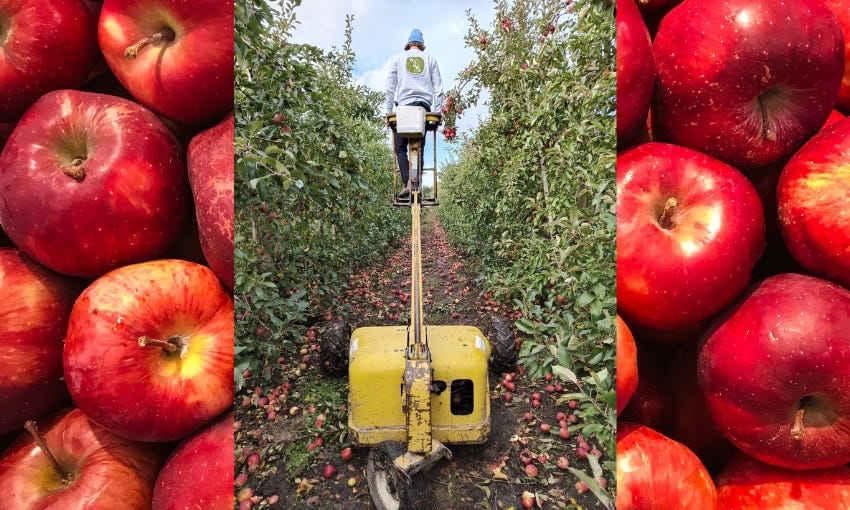How eating ‘ugly’ fruit and veg is a climate solution
Unrealistic beauty standards mean huge amounts of fresh produce never makes it past the farm gate.
Kia ora! Welcome to Future Proof. I’m Ellen, thanks for joining me this week.
Image credit: Wonky Box/Unsplash.
It was Boxing Day 2020 when a huge hailstorm battered the Nelson-Tasman region. Angus Simms and Katie Jackson were there: they’d recently picked up work at a couple of apple orchards. But soon the pair discovered they wouldn’t be able to pick the juicy red fruit, which had been damaged during the intense weather. You might be imagining apples pelted to a bruised pulp, but that was not the reality, according to Simms.
“What was quite shocking was seeing the fruit: it was like the tiniest little speck. It wasn't damaging to the fruit in terms of its freshness, quality, bruising or anything. It was just simply scars and that kind of thing. And we were like wow, this is actually insane,” he says. The idea for Wonky Box was born.
The food waste-climate connection
When food is chucked away, it rots and releases the planet-heating greenhouse gas methane. Around 4% of New Zealand’s greenhouse gas emissions are attributable to food and organic waste, according to the Ministry for the Environment. In a previous issue of Future Proof, we’ve looked at how food rescue charities are diverting tasty, high quality food from landfill.
Wonky Box operates in another part of the food supply chain: rescuing produce that would’ve never made it off-farm, due to its less-than-perfect appearance. The “wonky” produce is packaged up into a box of goodies and sold to consumers via a subscription service. “It costs a grower the same to grow a perfect piece of produce compared with a wonky bit of produce,” says Simms. The idea is to provide a fair price to both growers and consumers, with the added convenience factor of delivery direct to your door. Plus, climate change is at “the heart of everything” at Wonky Box, Jackson says, since tackling food waste is a particularly achievable climate solution that can make a difference now.
Unrealistic beauty standards
Fruit and veg is rated on appearance using a grading system: grade 1 is perfect, export quality. Grades 2 and 3 might be too small, too big, a weird shape, or too scarred or blemished. Simms estimates that 40% of produce never makes it past the farm gate. Some of the rejects are churned back into the soil as fertiliser, but other times there’s no other option but to leave it to rot. But with emerging requirements for growers to report on-farm emissions, many are seeking to move imperfect produce in novel ways – whether that’s through avenues like Wonky Box or Countdown’s “Odd Bunch”, or through making new secondary products like apple cider.
With the recent summer of extreme weather, Simms says there’s been an increase in rejections for fresh produce deemed not pretty enough. But it’s still nutritious and delicious, and growers still put in the effort to grow it, so why waste it? He hopes to see industry “dress code” standards loosen up a bit, but says it’s not only the supermarkets that are to blame. Consumers too have played a role in driving unrealistic beauty standards for fruit and veg. So perhaps it’s time to rethink our own cosmetic expectations and embrace the wonkiness.
If you're enjoying Future Proof and value what we do, please consider joining The Spinoff Members.
It’s because of our members that our small team of journalists are able to cover stories the length and breadth of New Zealand, then tell them in an engaging and compelling way. Every dollar donated exclusively funds our journalism and ensures we can tackle topics important to us and readers like yourself. Tautoko mai, join today.
Enter the Anthropocene
This week geologists announced that the Anthropocene began in 1950, ushering in a new geological age defined by humans. To find evidence of the new age, the Anthropocene Working Group scoured the globe for geological sites showcasing strong signals of change. A lake in Ontario, Canada, fit the bill, with a detailed record of human-caused change inscribed in its sediments. But the findings must be voted on by three geological organisations before we can officially enter the new era. How will the Anthropocene end? That’s a more important question than whether it’s yet begun, this editorial in The Economist argues (paywall).
Just two hours of mining adversely affected this deep-sea ecosystem
Scientists didn’t expect the mining test run on the seafloor to have much of an effect. But video footage collected by a remotely operated vehicle in an area mined for just two hours one year earlier revealed a significantly depleted ecosystem, according to new research. Another study predicts that tuna populations could plummet if plans to mine the seabed go ahead. This comes as the International Seabed Authority meets in Jamaica for three weeks of negotiations to decide on the international rules for seabed mining – or whether the controversial practice should go ahead at all.
What’s the difference between carbon neutral, zero emissions and net zero?
Scientific jargon is baffling at the best of times. And with the further complication of greenwashing, terms like “net zero” can be clear as mud. Danny Rood has a handy explainer for some key climate terms on The Spinoff, while Stuff’s Sarah Heeringa has some advice for consumers wanting to avoid greenwashing traps. While we’re on the topic of net-zero, here’s a good piece exploring how the concept has been co-opted by greenwashing governments and polluting corporations.
Making climate adaptation as fair as possible
A new guide explores how major disruptive changes can be turned into "just transitions": climate change, rapid technological change, employment changes in regions, and the transition to renewable energy offer opportunities for communities to come together to solve problems and transform unfair systems. In this episode of When the Facts Change, Bernard Hickey speaks to the guide’s authors.
More stories:
The High Court has ruled that the climate change minister must reconsider Emissions Trading Scheme settings, Marc Daalder reports for Newsroom.
Scientists have developed a white paint that can help to cool buildings.
Global food giant Nestlé is pursuing emissions reductions across its supply chain. What will this mean for Kiwi dairy farmers?
The US says it won’t pay reparations to developing countries affected by climate disasters.
Wind power, slower speeds and cleaner fuels: how dirty diesel ships can decarbonise.
The EU just passed a nature law that will require countries to introduce measures to restore nature across one-fifth of their land and seas by 2030.
New Zealand has pledged $19 million in climate finance to the Asian Mega-Deltas initiative, helping to develop climate-resilient farming in wetland areas in Asia.
Less growth, more art: an interview with professor Tim Jackson, director of the Centre for the Understanding of Sustainable Prosperity at the University of Surrey and author of Post Growth: Life After Capitalism.
Can urban agriculture deliver both economic and environmental benefits for cities?
In animal news: first it was orcas attacking rudders, now it’s Grand Theft Otter, with one rogue sea otter in California committing serial surfboard theft. Local photographer Mark Woodward has been sharing some great photos of the cute criminal on Twitter. The US Fish and Wildlife Service have been attempting to apprehend Otter 841 for relocation, but she remains at large as of writing.
Have an otterly amazing week,
Ellen
Got some feedback about Future Proof or topics you’d like covered? Get in touch with me at futureproof@thespinoff.co.nz













Even though I’m half the world away in the UK, your article resonates. We have Wonky Box companies here as well but their prices are too high for me.
We need an “Ungraded” category for all frit and veg